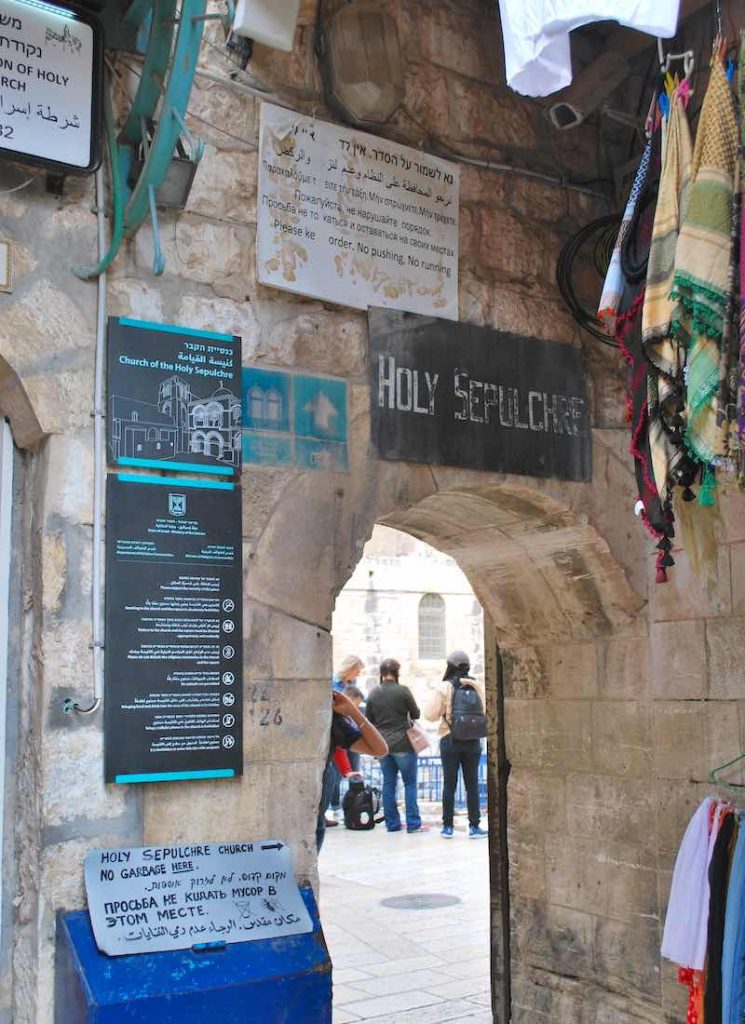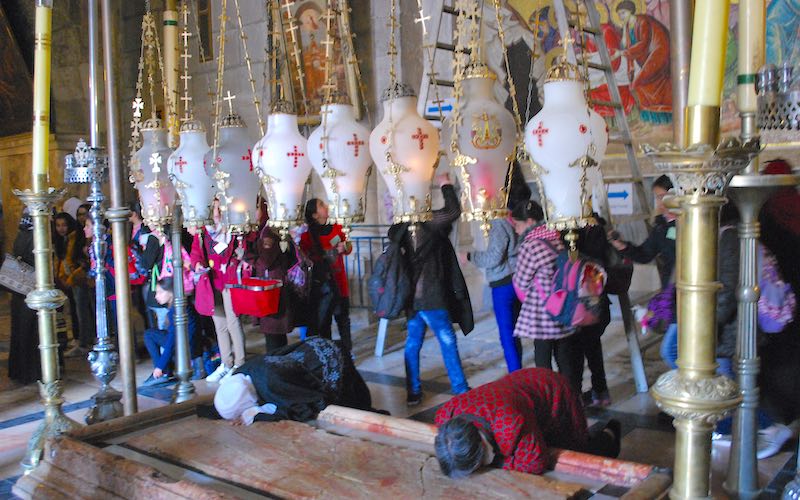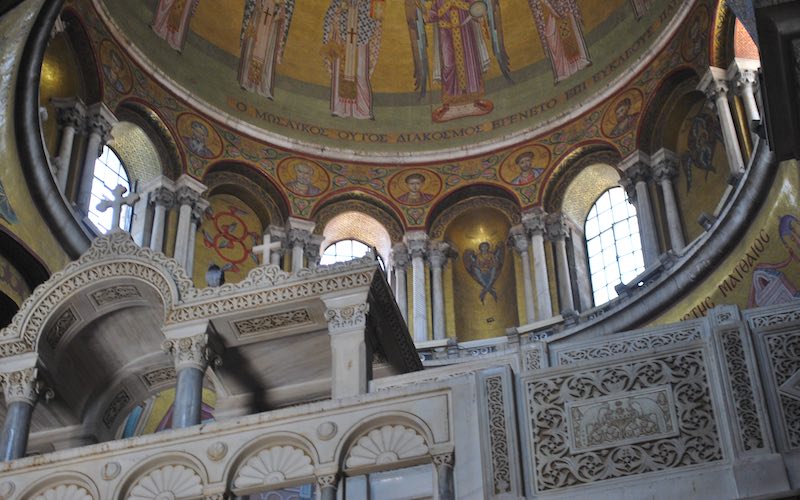It was just my second day in Jerusalem, and I headed into the old city with a fellow traveller. I didn’t intend to go straight for the Church of the Holy Sepulchre that day, but I’m glad that we stumbled upon it, as the rest of the itinerary turned out to be quite a busy schedule with tours and conferences to attend (Travel Bloggers Exchange Conference).
Disclosure: templeseeker.com is a participant in the Amazon Services LLC Associates Program and other affiliate advertising programs designed to provide a means for us to earn fees by linking to Amazon.co.uk, Get your Guide and other affiliated sites. Affiliate links may be used in this article on ‘The Church of the Holy Sepulchre, but they do not impact on the price that you pay and they do help me to get this information to you for free.
An Introduction to the Church of the Holy Sepulchre
The Church of the Holy Sepulchre is probably the most important Church in the world, as it houses the tomb of Jesus Christ himself. Located in the Christian quarter of Jerusalem’s Old City, whether you are on a Christian pilgrimage or a temple seeking tourist, this Church will surely impress. I was eager to see inside.

Photography copyright: All the images in this blog are original photography by Amy Green and are property of @templeseeker (unless otherwise stated). Please do not use these without permission or without giving credit. If you would like to use any of these images please email: amy@templeseeker.com for permission.
One blogger who I met at the TBEX conference said that he had an emotional moment. He reached the tomb of Christ, and one pilgrim was crying, overwhelmed with faith, He too started crying – he was moved even though he wasn’t that religious! So, if you only have time to visit one Church in Jerusalem, it should be this one.
When to Visit the Church of the Holy Sepulchre
The best time of year to visit Israel is the spring or autumn, when temperatures are warm and mild. I would recommend April-May or September-October. It is important to consider whether you want to attend or avoid the main events on the Christian calendar (Holy week and Christmas). They can be extremely busy times to visit and you may risk extensive crowds (and sometimes pick pockets when it is busy).
A word of advice on timing, go early in the morning – it gets extremely busy with pilgrims as early as 9am. Be aware that in the summer months, especially during the heat of the day, it can get very hot in Israel. It may be wise to visit early to avoid this. On my travels. I heard of people fainting in Churches – not good! We were there by around 10.30am and there were already brief queues to enter.
The Church itself is free to enter for both visitors and pilgrims alike. Do respect the facts that this is a very Holy place. Visit the Church quietly, and remember that not all people in the Church will be comfortable having their photograph taken whilst praying.
Finding the Church of the Holy Sepulchre
Hotels and Youth Hostels in Jerusalem are very tourist friendly and will be sure to share a map with you. (I highly recommend Abraham’s Hostel). The Old City itself is easy to navigate on foot without a map if you go during daylight hours and are eager to independently explore, although I wouldn’t recommend this unless you know where you are going.
As you delve deeper into the Christian quarter, it is likely that you could be approached and taken to the Church of the Holy Sepulchre, and be asked for money following this. It is not necessary, however, to donate to people on the streets who show you the way – it is well signposted anyway.

Inside the Church of the Holy Sepulchre
When you enter, you will immediately be greeted by the stone of the anointing. This is the place where it is said that Jesus’ body was prepared for burial (John 19:40), and it is the 13th Station of the Cross (Catholic, Orthodox, Anglican, Lutheran and Methodist Christians predominantly). The stations of the cross are based on a series of events on the day that Jesus was crucified and follow his route down Via Delarosa. Behind the stone of the anointing are stunning colourful mosaics depicting events from the passion of Christ.

A stunning colourful Greek mosaic is found behind the stone of the anointing. From the stone of the anointing, showing the body of Christ being taken down from the cross and anointed.

The Calvary
We immediately went up the steps to the right, which lead to the Calvary, built on Golgotha where Jesus was crucified. Part of the original Calvary stone of the hill is still exposed.
The Orthodox section of the calvary section of the Church is beautifully guilded with silver and gold. The Church is shared by several Christian denominations, predominantly Greek Orthodox, Armenian Orthodox and Roman Catholic, amongst others. This is a rarity in the Christian faith – quite often, denominations fail to agree.

Four Chapels of the Passion
Behind the Calvary, there is also an underground chapel of St Helena (Constantine’s mother) who discovered the true cross. Continuing round from the Calvary there are four chapels that signify aspects of Jesus’ suffering and death.
The first chapel is that of the prison of Christ. The second is the chapel of St Longinus, the Roman soldier who pierced Jesus’ side with a spear and blood and water immediately flowed out, at which point he said ‘truly this was the son of God.’ The third is the chapel of the Holy Rose. The fourth chapel of derision remembers the insults from the priests on the last journey to the crucifixion.
The Rotunda and Jesus’ Tomb
To the right of the main entrance you will go into the rotunda to see the tomb of Jesus Christ himself, which is stunning.

It is said to be empty, of course as the Catholic and Orthodox Christians believe in a physical resurrection of Christ. This is why the Church is often referred to as the Church of the Resurrection.
The Coptic Chapel and Syrian Chapel
If you continue to the back of the rotunda, you will also find a Coptic chapel. The stone inside the Coptic chapel is the back head of Jesus tomb, and the only place where you can see the original part of the tomb. Elsewhere, Jesus’ tomb is protected by marble stone.
At the very back of the rotunda is the entrance to the Syrian Chapel. Sadly, this room has deteriorated due to the conflict between the Syrians and Armenians over this room. The Syrian Orthodox Christians still use this room for Mass on Sundays. Sadly, no-one yet has full ownership of this section of the Church in order to renovate and maintain it.
Through the Syrian chapel, the tomb of Joseph of Arimathea can be found. According to all four gospels (Matthew, Mark, Luke and John), he was the man responsible for the burial of Jesus. The confirmation of this Jewish burial site confirms that this was the actual location of the death and burial of Christ.
The Chapel of the Three Mary’s
To the left of the entrance is the chapel of the three Mary’s. This is said to be the spot where Mary Mother of God, Mary Magdalene and Mary the wife of Cleophas stood by the cross of Jesus.
Resurrection Chapels – the Appearance of Jesus to Mother Mary and Mary Magdalene
On the right hand side of the Rotunda, two chapels can be found that commemorate the resurrection appearances of Jesus before he ascended to heaven to be with God. The first is the chapel of Mary Magdalene, the first resurrection appearance. Mary reached out to touch him, but he replied ‘touch me not’.
The second resurrection chapel (Franciscan) is that of the resurrection appearance to Jesus’ mother Mary. It is home to the column of flagellation of Christ (often referred to as the scourging of the pillar), where Jesus was tied and whipped before his crucifixion.
My One Regret about my visit to the Church of the Holy Sepulchre
I have one key regret about this visit – I should have hired a local guide to explain the detail and history of the Church, like when I visited the Church of the Nativity. Most of my research happened on the evenings and even some of it on my return to the UK, as the trip was so intense. Ah well, I guess I will just have to go back. I have no doubt that Jerusalem, the Holy City, will be calling me again very soon!
I love this video by Jerusalem Experience.
Where to stay in Jerusalem
I advice that you spend at least 3-5 days in Jerusalem to admire what the Holy City has to offer. You may want to spend longer if you would like to explore other sites of Israel including Bethlehem, Nazareth and Qumran for the Dead Sea Scrolls. Personally, I would spend months exploring this place! If you want somewhere more modern and less culturally intense, you can stay in Tel Aviv.
If you are on a budget, I recommend staying in Abraham’s Hostel. They also offer guided tours and excursions.
Tours of the Holy City Jerusalem
Sandeman’s walking tours run free tours of Jerusalem, but if you are looking for one that takes you into the Holy Sites including Temple Mount and Church of the Holy Sepulchre, book the Sandeman’s Jerusalem Three Religions Holy City Walking Tour.
If you are looking to pre-book a more extensive Jerusalem tour including the Mount of Olives and also to be guaranteed to see the Church of the Holy Sepulchre, book online with Viator.com.
Further Reading on Israel
If you are travelling to Israel then you might also enjoy the following blog articles…
- Solo Travel Israel – The Ultimate Guide
- Photographs that will make you want to explore Mount Zion
- Churches in Jerusalem


Pingback: Churches in Jerusalem you can't miss - Best Jerusalem Churches
definitely on my bucket list